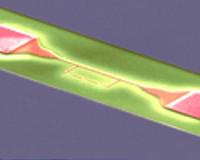 |
College Park MD (SPX) Aug 05, 2010 Researchers at the University of Hawaii at Manoa say that the Leeward side of Hawaiian Islands may be ideal for future ocean-based renewable energy plants that would use seawater from the oceans' depths to drive massive heat engines and produce steady amounts of renewable energy. The technology, referred to as Ocean Thermal Energy Conversion (OTEC), is described in the Journal of Renewable and Sustainable Energy, which is published by the American Institute of Physics (AIP). It involves placing a heat engine between warm water collected at the ocean's surface and cold water pumped from the deep ocean. Like a ball rolling downhill, heat flows from the warm reservoir to the cool one. The greater the temperature difference, the stronger the flow of heat that can be used to do useful work such as spinning a turbine and generating electricity. The history of OTEC dates back more than a half century. However, the technology has never taken off - largely because of the relatively low cost of oil and other fossil fuels. But if there are any places on Earth where large OTEC facilities would be most cost competitive, it is where the ocean temperature differentials are the greatest. Analyzing data from the National Oceanic and Atmospheric Administration's National Oceanographic Data Center, the University of Hawaii's Gerard Nihous says that the warm-cold temperature differential is about one degree Celsius greater on the leeward (western) side of the Hawaiian Islands than that on the windward (eastern) side. This small difference translates to 15 percent more power for an OTEC plant, says Nihous, whose theoretical work focuses on driving down cost and increasing efficiency of future facilities, the biggest hurdles to bringing the technology to the mainstream. "Testing that was done in the 1980s clearly demonstrates the feasibility of this technology," he says. "Now it's just a matter of paying for it."
Share This Article With Planet Earth
Related Links American Institute of Physics Powering The World in the 21st Century at Energy-Daily.com
 One More Step On The Path To Quantum Computers
One More Step On The Path To Quantum ComputersMunich, Germany (SPX) Aug 03, 2010 Researchers around the world are working on the development of quantum computers that will be vastly superior to present-day computers. Here, the strong coupling of quantum bits with light quanta plays a pivotal role. Professor Rudolf Gross, a physicist at the Technische Universitaet Muenchen (TUM), and his team of researchers have now realized an extremely strong interaction between light ... read more |
|
| The content herein, unless otherwise known to be public domain, are Copyright 1995-2010 - SpaceDaily. AFP and UPI Wire Stories are copyright Agence France-Presse and United Press International. ESA Portal Reports are copyright European Space Agency. All NASA sourced material is public domain. Additional copyrights may apply in whole or part to other bona fide parties. Advertising does not imply endorsement,agreement or approval of any opinions, statements or information provided by SpaceDaily on any Web page published or hosted by SpaceDaily. Privacy Statement |